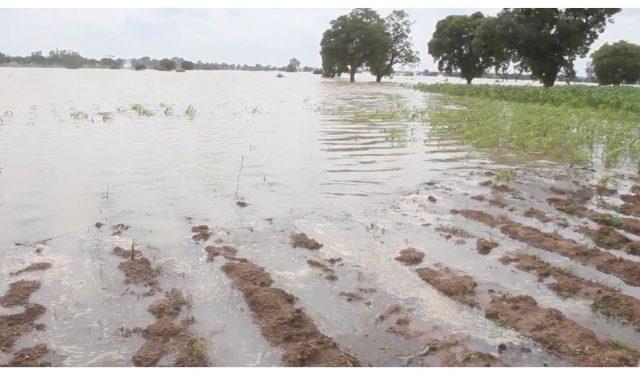Every year, communities in the Upper East Region of Ghana brace themselves for the looming disaster that accompanies the spillage of the Bagre Dam in Burkina Faso.
This annual event, intended to prevent the dam from overflowing, has become synonymous with devastation for many Ghanaian communities downstream. For over two decades, the spillage has had severe socio-economic implications, wreaking havoc on farmlands, destroying homes, and disrupting the livelihoods of thousands of residents.
The recurrent nature of this phenomenon makes it a critical issue that demands urgent and sustainable solutions.
The Bagre Dam, located on the White Volta River in Burkina Faso, serves multiple purposes, including irrigation, hydropower generation, and flood control. However, during the rainy season, when water levels rise significantly, the dam must release excess water to maintain its structural integrity.
Unfortunately, this spillage flows downstream into northern Ghana, particularly affecting communities in the Upper East Region. The timing of the release often coincides with the peak of the farming season, compounding the devastation for local farmers who rely heavily on the White Volta River for irrigation and agriculture.
Agriculture is the backbone of the economy in the Upper East Region, with the majority of the population engaged in farming and rearing of livestock. The spillage of the Bagre Dam has a direct and destructive impact on this sector. Large swathes of farmland are submerged under water, causing severe crop losses.
This results in reduced agricultural output and a loss of income for farmers, many of whom operate on a subsistence basis. The destruction of staple crops like maize, millet, and rice, as well as cash crops such as tomatoes and onions, creates food shortages and undermines the region’s food security.
The livestock sector is also affected, as animals are swept away by floodwaters or die from lack of pasture due to inundation. This has a cascading effect on livelihoods, as many families depend on livestock as a secondary source of income. The result is a vicious cycle of poverty and food insecurity, as affected households struggle to recover from the economic shocks induced by the annual spillage.
The sudden rise in water levels during the spillage often leads to severe flooding of communities situated along the banks of the White Volta River. Many houses, particularly those constructed with mud and other local materials, are washed away, leaving families homeless and vulnerable. The loss of property is not limited to homes, businesses, shops, and community infrastructure such as schools and health centers are also affected, disrupting social and economic activities.
The displacement of families due to the floods leads to temporary relocation to higher grounds or makeshift shelters, which are often ill-equipped to support large numbers of people, creating further humanitarian challenges.
Flooding resulting from the Bagre Dam spillage has serious implications for public health and sanitation in the Upper East Region. Stagnant water becomes a breeding ground for mosquitoes, leading to an increase in malaria cases.
Additionally, the contamination of water sources heightens the risk of waterborne diseases such as cholera and dysentery. During and after the spillage, access to clean water is severely compromised, forcing residents to rely on unsafe water sources. The health implications are particularly severe for children and the elderly, who are more susceptible to disease outbreaks.
Furthermore, the flooding destroys sanitation infrastructure such as latrines, creating open defecation zones and further exacerbating health risks. The resulting strain on healthcare facilities, many of which are already under-resourced, highlights the urgent need for targeted health interventions and emergency preparedness measures in the region.
The annual flooding caused by the Bagre Dam spillage disrupts the academic calendar in many affected communities. Schools are often submerged, and access routes are cut off, preventing students and teachers from attending classes.
The displacement of families also means that children are temporarily relocated, further affecting their education. In the long term, the interruption in schooling impacts educational attainment and contributes to higher dropout rates, particularly among girls who may be more vulnerable to the socio-economic pressures caused by the flooding.
In addition to education, other social services such as healthcare and community development projects are put on hold due to the floods. The focus shifts from development to emergency response, as resources are diverted to provide immediate relief for affected families and communities. This hampers the overall development of the region and perpetuates a cycle of underdevelopment and vulnerability.
The cumulative economic cost of the Bagre Dam spillage on the Upper East Region is immense. Beyond the immediate loss of crops, livestock, and property, the disruption to economic activities has long-term implications for poverty and development in the region.
Local markets are often flooded, disrupting trade and causing prices of essential goods to spike. Transport networks are damaged, cutting off communities and hindering the flow of goods and services. For many households that depend on seasonal farming and petty trading, the economic setbacks are devastating, pushing them further into poverty.
The annual spillage has also taken a psychological toll on the people of the Upper East Region. The fear and anxiety that accompany the onset of the rainy season create a sense of perpetual insecurity.
The uncertainty of whether their homes and livelihoods will be swept away again prevents residents from investing in long-term development projects. Culturally, the flooding disrupts social and community activities, as traditional ceremonies and festivals are postponed or canceled due to the displacement of people and the destruction of communal spaces.
While emergency relief efforts are critical in the aftermath of the Bagre Dam spillage, there is a pressing need for long-term, sustainable solutions to address the recurrent flooding. One such solution is the construction of the Pwalugu Multipurpose Dam, which has been proposed as a mitigation measure to control the flow of water downstream and reduce flooding. Additionally, improved water management and early warning systems can help communities prepare for the spillage and minimize its impact.
The government and relevant stakeholders must also invest in building resilient infrastructure, such as flood-resistant housing and community facilities, to reduce the vulnerability of affected communities. Enhancing livelihood diversification through the promotion of alternative income-generating activities can also help reduce the economic dependence on agriculture, making households more resilient to the impacts of the flooding.
The annual Bagre Dam spillage has far-reaching implications for the people of the Upper East Region, affecting their livelihoods, health, education, and overall well-being.
Addressing this challenge requires a comprehensive and multi-sectoral approach that goes beyond emergency relief to include sustainable development strategies, infrastructure investment, and community resilience building. Until these long-term solutions are implemented, the people of the Upper East Region will continue to bear the brunt of this man-made disaster, with each spillage eroding their hopes for a stable and prosperous future.
Edgar Balinia Adda
International Development Specialist
Halifax, Nova Scotia, Canada

















